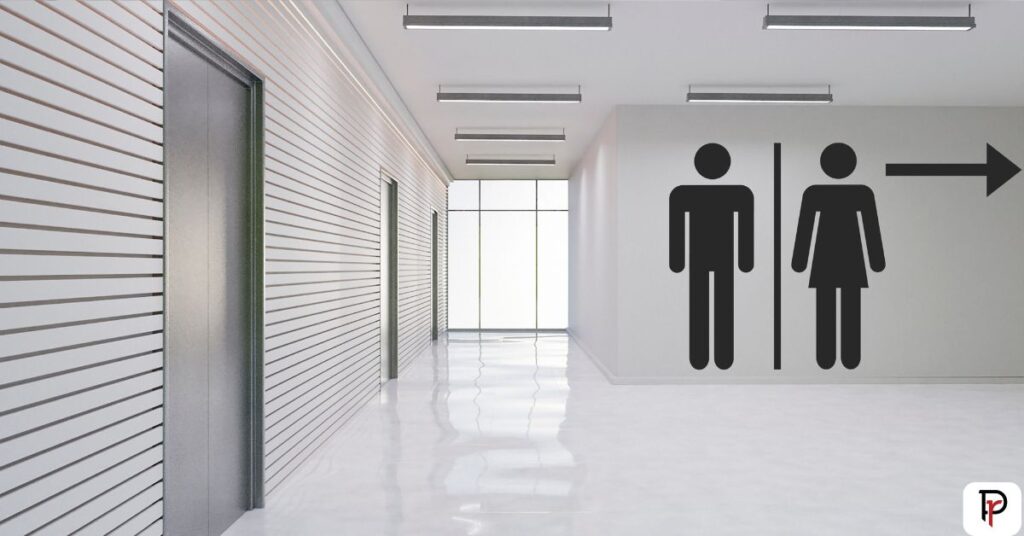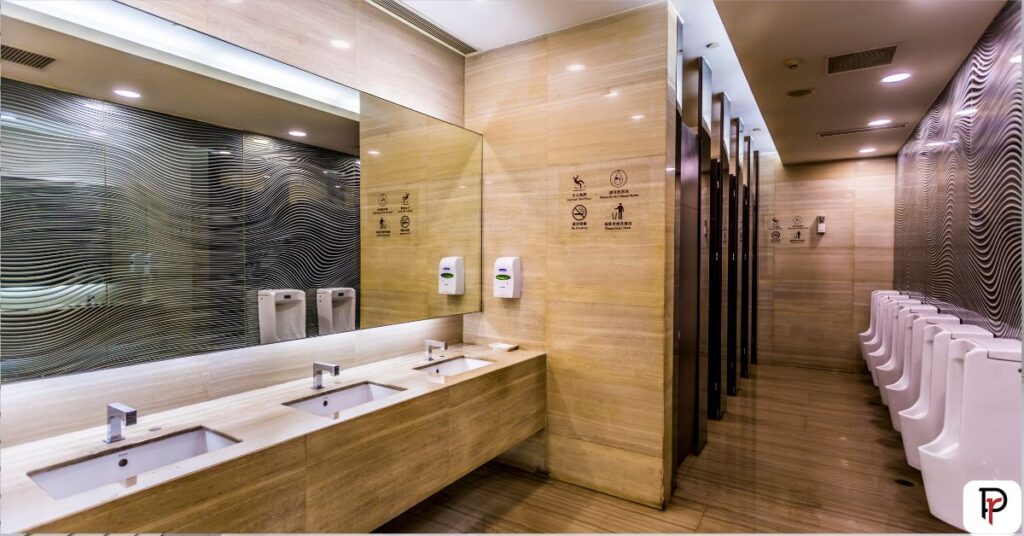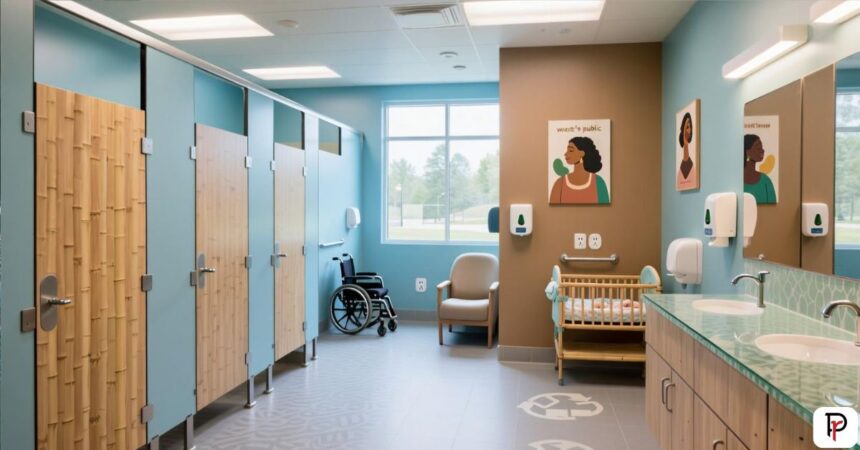Introduction
Public restrooms are essential to urban spaces, yet they often fail to meet the diverse needs of users, particularly women. Problems such as lack of privacy, cleanliness concerns, and accessibility challenges persist globally. Enter the SQRWomensRestroom, an innovative concept that redefines the standards of public restroom design. This groundbreaking solution integrates advanced technology, sustainability, and user-centered design to address the shortcomings of traditional women’s restrooms.
This blog explores the SQRWomensRestroom concept, how it resolves common issues, and why it holds the potential to shape the future of public amenities.
The Problem with Traditional Women’s Restrooms
Despite their significance, traditional public restrooms often lag in essential areas such as hygiene, safety, and usability. Here are some common issues women encounter:
- Hygiene Concerns: Women often avoid public restrooms due to unsanitary conditions, poor ventilation, and lack of maintenance.
- Limited Privacy: Basic structures fail to offer a sense of safety and respect for privacy.
- Accessibility Issues: Women with disabilities, mothers managing young children, and those needing supportive amenities are often neglected.
Additionally, outdated designs rarely consider the needs of high-traffic locations such as airports or shopping malls, creating a pressing demand for efficient alternatives like the SQRWomensRestroom.
ALSO READ THIS POST: Transphotonen: Unlocking the Future of Quantum Photonics
What Is the SQRWomensRestroom?
At its core, the SQRWomensRestroom represents a leap forward in public restroom designs. It combines user-centric features with cutting-edge technology to provide comfort, hygiene, and accessibility for women. Unlike traditional restrooms, the SQRWomensRestroom focuses on inclusivity and efficiency:
- Enhanced Privacy: Enclosures are designed to prevent gaps, ensuring users feel secure.
- Tech-Enabled Cleanliness: Facilities include self-cleaning features that activate post-use.
- Smart Solutions: Sensors for hands-free operation of doors, faucets, and flush systems contribute to a hygienic experience.
The SQRWomensRestroom aims to be more than just a functional utility—it aspires to humanize public spaces through purposeful design.

Design and Technology
The innovative design of the SQRWomensRestroom integrates several principles. Below, we detail its key features:
Inclusive Design
Special attention is given to providing accessibility for:
- Women with disabilities, with wheelchair-compatible stalls.
- Mothers, with changing stations and child-friendly amenities.
- Pregnant individuals, with ergonomic layouts ensuring convenience.
Sustainability
The SQRWomensRestroom employs eco-friendly materials and water-saving fixtures. Smart taps reduce water waste by delivering optimal usage based on sensor data, and energy-efficient lighting powered by solar panels minimizes its carbon footprint.
Sample Table: Hygiene and Sustainability Features
| Feature | Description | Benefit |
|---|---|---|
| Touchless Faucets | Operated via motion sensors | Enhanced hygiene, water savings |
| Self-Cleaning Tech | Automatic disinfection after every use | Ensures cleanliness |
| Recycled Materials | Constructed with sustainable, reusable building materials | Conserves resources |
Smart Solutions
Modern technology allows for:
- Real-Time Tracking: Displays showing restroom vacancy status, reducing waiting times.
- Air Sterilizers: Advanced air circulation systems eliminate odors and bacteria.
- Touchless Operations: Doors, soap dispensers, and dryers fully automated for maximum convenience.
Benefits of the SQRWomensRestroom
The SQRWomensRestroom transforms the restroom experience in meaningful ways:
- Comfort and Privacy: With thoughtfully designed partitions, women can use the facilities without concerns over safety or intrusion.
- Hygiene Excellence: From touchless interactions to frequent auto-cleaning cycles, hygiene is prioritized.
- Universal Accessibility: Sufficient space and adaptive designs ensure inclusivity for all users.
- Environmental Benefits: With its sustainable infrastructure, it sets a model for eco-conscious public services.
Target Audience and Use Cases
The SQRWomensRestroom serves numerous user groups and settings:
User Groups:
- Businesswomen rushing through metropolitan transit systems.
- Mothers with toddlers in need of changing stations.
- Differently-abled individuals requiring wheelchair-friendly facilities.
Ideal Locations:
- Public Transport Hubs (e.g., subway systems and airports).
- Shopping Complexes and Entertainment Venues.
- Urban Parks and Recreation Areas.
By catering to diverse demographics, the SQRWomensRestroom ensures inclusivity in public spaces.

Case Studies and Real-World Applications
Cities like Tokyo and Helsinki have showcased prototypes of the SQRWomensRestroom with impressive results. For instance:
- Pilot Programs in Airports: Several international airports now install SQRWomensRestrooms for travelers’ convenience.
- User Testimonials: Surveys conducted post-implementation highlight a significant increase in user satisfaction regarding hygiene and accessibility.
These success stories underscore its effectiveness as a viable solution for public amenities.
Challenges and Limitations
While the SQRWomensRestroom is innovative, it isn’t without obstacles:
- Installation Costs: Advanced technologies and sustainable materials require substantial initial investment.
- Maintenance Demands: Ongoing staffing and resources are needed to ensure peak functionality.
- Adoption Hurdles: Traditional infrastructure may resist upgrades, slowing down widespread implementation.
However, with proper strategies such as policy reforms and community outreach, these barriers can be addressed.
Future of Public Restroom Design
The principles demonstrated by the SQRWomensRestroom pave the way for continued innovation:
- AI Integration: Future iterations may involve AI to predict peak restroom usage times for smoother operation.
- Customizable Amenities: Users might soon adjust temperature or playlist preferences within individual stalls.
- Global Standards: The design could inspire worldwide benchmarks for sustainable urban planning.
Conclusion
The SQRWomensRestroom exemplifies innovation at its best, blending technology with design to enhance women’s public restroom experiences. By delivering comfort, accessibility, and sustainability, it sets a new benchmark for urban infrastructure. Policymakers, urban developers, and community leaders are encouraged to champion such projects to create inclusive public spaces for all.
FAQs
- What materials are used in constructing the SQRWomensRestroom?
Recycled and sustainable materials like bamboo composites, recycled plastics, and low-VOC paints are utilized for eco-friendliness.
- How does the SQRWomensRestroom compare to traditional public restrooms in energy consumption?
It uses energy-efficient systems like LED lighting and solar-powered ventilation, significantly reducing utility costs.
- Are there any provisions for emergencies, such as running out of supplies?
Yes, smart inventory systems monitor supply levels in real-time, ensuring quick restocking when needed.
- Can the SQRWomensRestroom be installed in older buildings?
Yes, modular designs allow retrofitting into existing infrastructure without large-scale renovations.
- What feedback mechanisms exist for users?
Digital interfaces at exits collect feedback to help authorities monitor satisfaction and maintenance needs.
This blog provides a comprehensive guide to the revolutionary SQRWomensRestroom while addressing key concerns, thus driving awareness and advocacy for its adoption.
